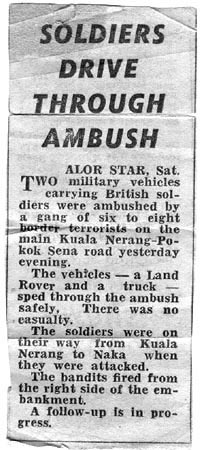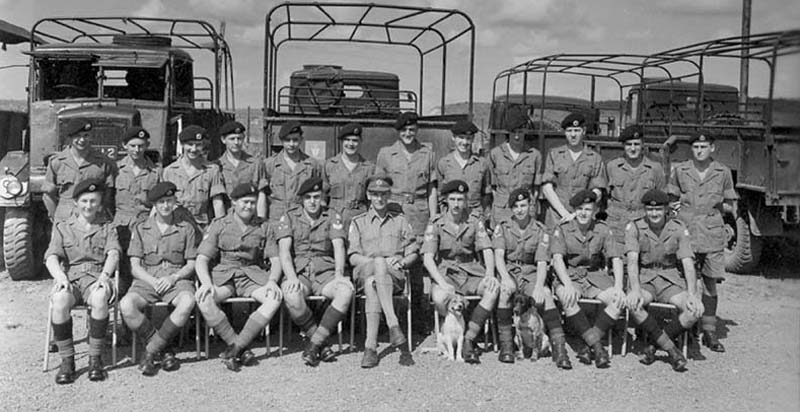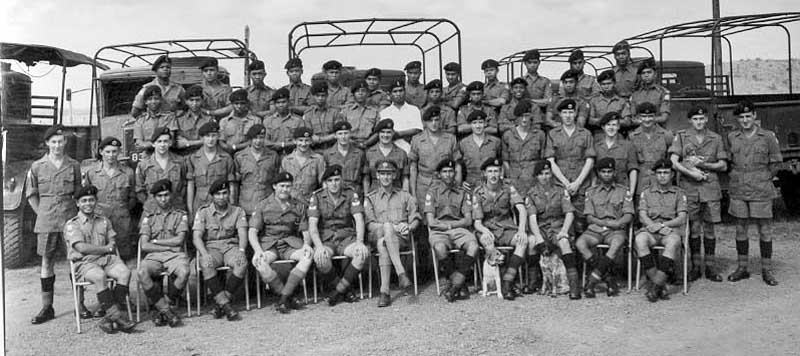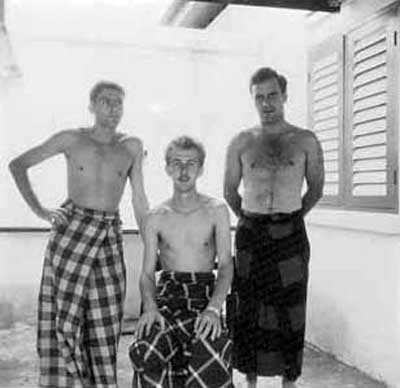
Alf & Capt Hugh Taylor R. Aust. Svy. Corps
Recollections of my early days in Singapore
Introduction
When someone asks you to recall events that happened some fifty years ago, I find it rather difficult, especially remembering the names - so I shall leave out all names and I shan’t upset anyone.!
Leaving Harrogate
In 1955, having just left the Army Apprentices School Harrogate, I completed my combat engineer training in Cove, followed by a short course at Hermitage so I was then considered ready for my first posting abroad as a regular soldier. Singapore was the result, but where was that? - a quick look at the atlas confirmed its position and the fact it was a long way from home.
However, first it was off to Barton Stacey, which at that time was the Royal Engineers Depot and Transit Camp, in rural Hampshire, with everyone coming from and going to all manner of places throughout the world. Here we were kitted out with our tropical uniforms, received our jabs and general medicals for overseas service. These were the days long before air transport was in regular use and we destined to travel by troop-ship. From Barton Stacey it was off by train to Liverpool and join our ship, not an exotic cruise liner, but an old ship with huge funnels which they say could be seen on the horizon a day or two before the boat itself could be seen.
Life on a Troopship
There was a mixture of
personnel on board from whole battalions to lowly individuals. We
were housed in the bowels of the ship below the water line and our
only air conditioning was a huge canvas tube from the main deck down
to our own living quarters which
funnelled air
below decks whilst we were on the move. The journey as I remember it
took over five weeks. We docked in Port Said (but we were not allowed
to disembark the ship), followed by Aden and Colombo. The journey
from Aden to Colombo was terrible as there were tremendous storms and
I didn't leave my bunk for days, due to violent sea sickness.
Formation of 84 Fd Svy Sqn RE
On arrival in Singapore we found that we were joining a newly formed 84 Field Survey Squadron RE. At the same time 570 Map Reproduction Troop RE was also being mustered. Several members of a small survey section, which were already stationed in Singapore then became members of these new units and were able to show us the ropes and initiate us to the life style of Singapore. The Survey Squadron had its administrative office in Gillman Barracks, but the staff and technical personnel were accommodated in Rowcroft Lines, along with members of the local REME Workshops.
Jungle training and learning the language
Over the next six months everyone was busy and attending courses to prepare for the tasks and jobs we had ahead of us - this involved considerable time and work “up country” in Malaya. One of the prime courses we attended was the Malay Language course at Nee Soon. The reason was twofold first we were going to be working out in the countryside and secondly our escorts were provided by the Malay Pioneer Corps. These were dangerous times in Malaya since there was a continuing war in the jungle and certain urban areas against the communist terrorists. Another essential preparatory training courses was the jungle training course in Johore ( Kota Tingi ), a place I was to get to know very well later in my tour, when I was involved in a detailed survey of the complete area, this was where we all learnt not to be afraid of creepy crawlies. including leeches. My first survey task in Singapore was to look after a heliograph on Mt. Faber, which was then positioned over a metal gun platform, shining down to a position on Blakang Mati Island - the home base for the Royal Artillery.
A move to permanent accommodation
During the early months of 1956 the Squadron moved to Kuala Lumpur (KL) and took up residence in Batu Cantonment. As I recall, we were spread around with our technical offices, store areas and squadron office dotted all over the camp. Later on we were to have a purpose built compound to encompass most requirements except living accommodation. Our Squadron was a good mix of regular soldiers and national servicemen from all walks of life. There was an excellent carpenter who soon constructed a clubroom, where we could relax during the evenings. The bar in the club-house was made from planks cut from old railway sleepers.
Work and Jungle Operations
Very soon the field troops moved out and started their task of providing revised information to update the existing mapping. This was all very well when you were in the open countryside but when you ventured into the jungle it was a very different story. When your vision is restricted to ten or twenty yards your whole method of navigation has to change. We did of course have the old maps, however navigating by contours, time, compass direction, aerial photographs and the occasional river was an entirely new technique. In addition we had to be on guard against possible attack by an enemy patrol.
Since we moved from area to area on a regular basis after completion of each map our accommodation varied considerably. We lived in empty buildings in rubber plantations, pineapple plantations, tea plantations, in tents on village greens and from time to time in army camps where all was provided. I can remember at one time we were in tents on the edge of an airfield and when the monsoons came and the whole area was covered in water. All our belongings were elevated on large tent pegs and every night we paddled to our beds which were just above water level.
My first real jungle experience was really quite dramatic for me; I had not long been promoted to L/Cpl and we were on patrol tracing jungle routes and our troop Sgt was in charge of the patrol. After about five to seven days we were to be re-supplied by air drop. Having cleared the drop zone to make it large enough to be identified we radioed in and a light aircraft came over to approve the sight for the larger supply aircraft. This having been done and the approval dropped in a message bag we awaited the arrival of the supply aircraft itself. Well sure enough the aircraft was heard and the Sergeant started to prepare his very pistol to help identify us to the pilot, unfortunately the trigger mechanism of the pistol was much too slack and before he could fully draw the weapon the shot went down the side of his leg and he injured himself quite badly. At the time he was also suffering from some tree poison he had touched, so he was really in quite a bad way. Our native bearers were very good and treated him with ashes from the fire, which relieved him from some of his worst symptoms, however he was certainly unable to continue with the patrol. As I was the next senior rank I had to take over and arrange a casualty evacuation, this was done by helicopter. After this I was instructed from Headquarters to continue with the patrol - I really had completed my initiation!
Christmas in the Cameron Highlands
My first Christmas in Malaya was spent in the jungle around the Cameron Highlands in a camp which had been built into the jungle itself. Our Christmas supplies were brought in by the OC and the SSM by helicopter. I seem to remember it was an very enjoyable occasion. During a tour in Malaya, if you were lucky, you were given a two week secondment to the Cameron Highlands, a hill station, for a change of air. It wasn’t a holiday as you had to do duties while you were there, but it was really quite relaxed. During the evening it was quite chilly, so log fires were a feature and a reminder of home. I remember one of my duties was a night shift manning the switchboard at the forces childrens’ boarding school. The two week change was really a very refreshing break.
Where is my rifle?
If ever you had to travel by rail, which was almost always an overnight trip, you had to travel in uniform and were called upon to do a stint as armed guard as there were times when the train had been attacked. One of my worst experiences, and I can’t remember which area it was, but, we had stopped to do some annotation on the air photos and I had everything spread out on the wing of the vehicle and my rifle was leant against the truck. Having completed our work we all climbed back into the truck and moved on to our next point. We then repeated the procedure. But where was my rifle? Panic set in, I could only have left it at our previous location.
After a high speed
return and visions of me looking out from behind bars, we were met by
a whole load of locals returning to their village after work and in
the middle of them a chap holding aloft my rifle. Never in my life
have I been so relieved as it so easily could have gone the wrong way
and my life and military career could have taken a completely
different direction.
Squadron Tasks
One of the larger tasks in which we were involved was a survey of the area for the building of the Bukit Terendak camp in Malacca, lots of leveling was involved and I remember it being very hot as we were out in the full sun for most of the day. After work we often used to go down to the beach for a swim and it was here that one of our troop was caught up and stung by a Portuguese Man of War, the jelly-fish. I remember that he became delirious and was in hospital for several days before he finally recovered enough to return for work. A frightening experience.
From time to time we were called to move out in a hurry to establish TDP (target director points). I think these were for use by the artillery or to guide aircraft, I never did meet the end customer. Very often it was just myself and a driver. As you had to provide panoramic sketches it was then you found some hidden talents, some of our drivers were very talented artists.
As young junior NCOs we had quite a lot of responsibility one of which was liaising with the Operation Officers responsible in the various areas. Each area was the responsibility of UK and Commonwealth infantry units and or Malay police. When a young NCO turned up to ask permission to work in a particular area there were some very strange reactions at times. All villages were surrounded by barbed wire fencing and at night even if the locals were working outside the perimeter during the day they had to be inside again before nightfall. We as military were not allowed to travel in single vehicles and each troop had an armoured scout car. In some areas you were only allowed to travel in convoy escorted by the infantry working in that area.
In 1957, our attached Australian officer and I were seconded to the Australian infantry for a special sortie to try and find Ching Peng, the notorious leader of the communist guerillas. We did quite a lot of pre-op training before going on what was to be my longest period on jungle patrol. The idea was that we should trace the base camp they were using and to the best of our ability guide in the RAF.
Obviously we couldn’t get very close but we were hoping that with the aid of a guide, a surrendered terrorist, we would be able to get into close proximity. It was then up to us surveyors to fix our position and give a bearing and distance into the camp. Our equipment for obvious reasons, we were also carrying fourteen days rations, had to be as light as possible. We used a Kern miniature theodolite with tripod, a Curta calculator, books of natural tables, star charts and other odd items. Each night we had to find a position with enough view to see the stars, and then observe enough to fix our position.
At one stage the two of us were left on our own while the patrol went to do some exploration. I think they thought they were close to the target and that it was too dangerous for us lowly surveyors. It was several days before they returned, and the only thing they had found was one of the enemy’s food dumps. This was good for us as a supplement to our boring rations. We had Ready Brek daily for breakfast and the only meat for our main meal was corned beef which we had with Oxo one day and curried the next. Our share of the booty was a tin of Scots porridge oats. We found several old campsites some of which had been bombed, but unfortunately we never found an occupied camp. We were re-supplied by foot patrol halfway through the sortie which lasted approximately thirty days.
During the whole period we were not allowed to wash or brush our teeth as it was possible that the smell would have given us away. On returning to base camp I had the best shower of my life. This was the only time during my army career that I was officially allowed to grow a beard.

Alf & Capt Hugh Taylor R. Aust. Svy. Corps
During survey work in
the Seremban area we kept getting disorientated and we just could not
puzzle out why, were the maps wrong, were we being stupid in some
way. Eventually we came up with the answer, it was a magnetically
anomalous area, so no matter how hard you tried you could not use a
magnetic compass.
The tour draws to a close
My last working area was up near the Thai border area and I was in charge of a small section at a place called Naka. It was a nice village with very friendly people. Our hut was beside the river and close by was a Malay family. The lady of the house, when she was cooking, used to pass us a plate full of goodies. The area was quite flat and covered in padi(rice growing)fields. There were plenty of tracks but not many roads on which we could use vehicles. Much to our amazement we were supplied with bicycles, so every day would see us pedaling away with our weapons strung over our shoulders and our map boards on the handlebars. One day we were invited into a wedding reception in a remote village. Some of our members could not keep their balance when cycling along the padi field embankments so they got a regular soaking when they fell in the water. As it was a very small place, apart from the local coffee shop, there was not a lot to do in our off duty hours. HQ in Kuala Lumpur, with the profits from the squadron bar, had bought the field troops a battery operated record player and after our evening meal we all used to relax to the only record we had at the time, an LP of Dave Brubeck, I think we all knew every single note on that disc. My mind still floats back to those days when ever I hear him on the radio.
During this period I was recalled to Kuala Lumpur for a meeting and while I was away our vehicles, when going to pick up rations, were fired upon and thankfully no one was hurt but there were several bullet holes in the 3 tonner.

On my return to Naka I carried out my last patrol which was an initiation for our new Troop Sergeant because at this time the original members of 84 Sqn were coming to the end of their three year tour of duty, myself included. At this stage, it was back to Kuala Lumpur to end what was a very adventurous and interesting time of my life and I had even managed to get promotion to full Corporal.
Thankfully the troopship on which I returned to England was much newer and therefore much faster than the one I had taken some three years earlier, although it still took a full three weeks to get back to UK.
Here is Photo of the troop c. 1957, names anyone, please

To the left of the Officer is Tommy Thompson and to the
Officer's right is Alf Isherwood with Neddie at his feet.
Back row right hand side as you look at the picture
on the end was Ian Kilgour and next to him was Keith Taylor.
Front row - 2nd from right end - Ben Howson
Back row - 3rd from left end - Peter Golding - centre - Dave Harries - 2nd from right end - Ted Cloke
The officer in the front row next to Alf is probably Capt. Robertson (Sqdn 2i/c) if the photo was taken before Sept. 1957.
Additions and corrections wanted--Albie

The full Troop with Malay Pioneer Corps

Alf at Rowcroft Lines, Singapore 1955

Ian Kilgour, Alf Isherwood & Keith Taylor Kota
Tinggi Area circa 1957.
With thanks to Alf Isherwood for this contribution, also published in Newsletter No22.